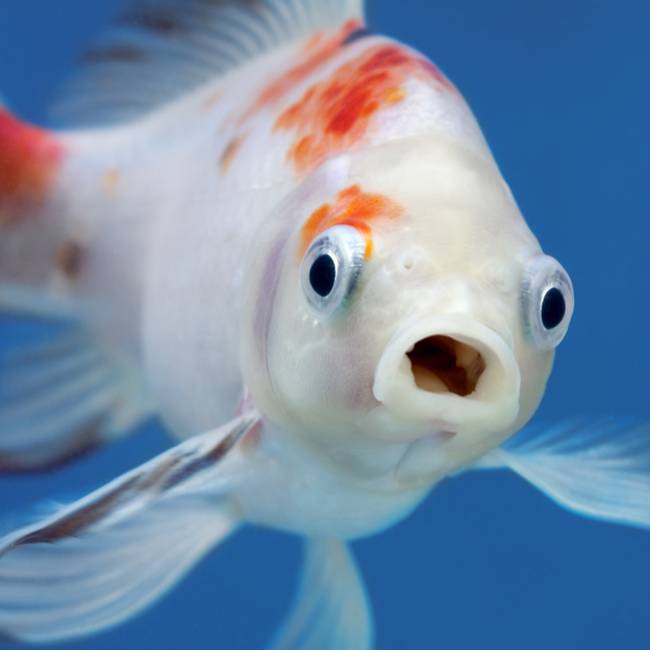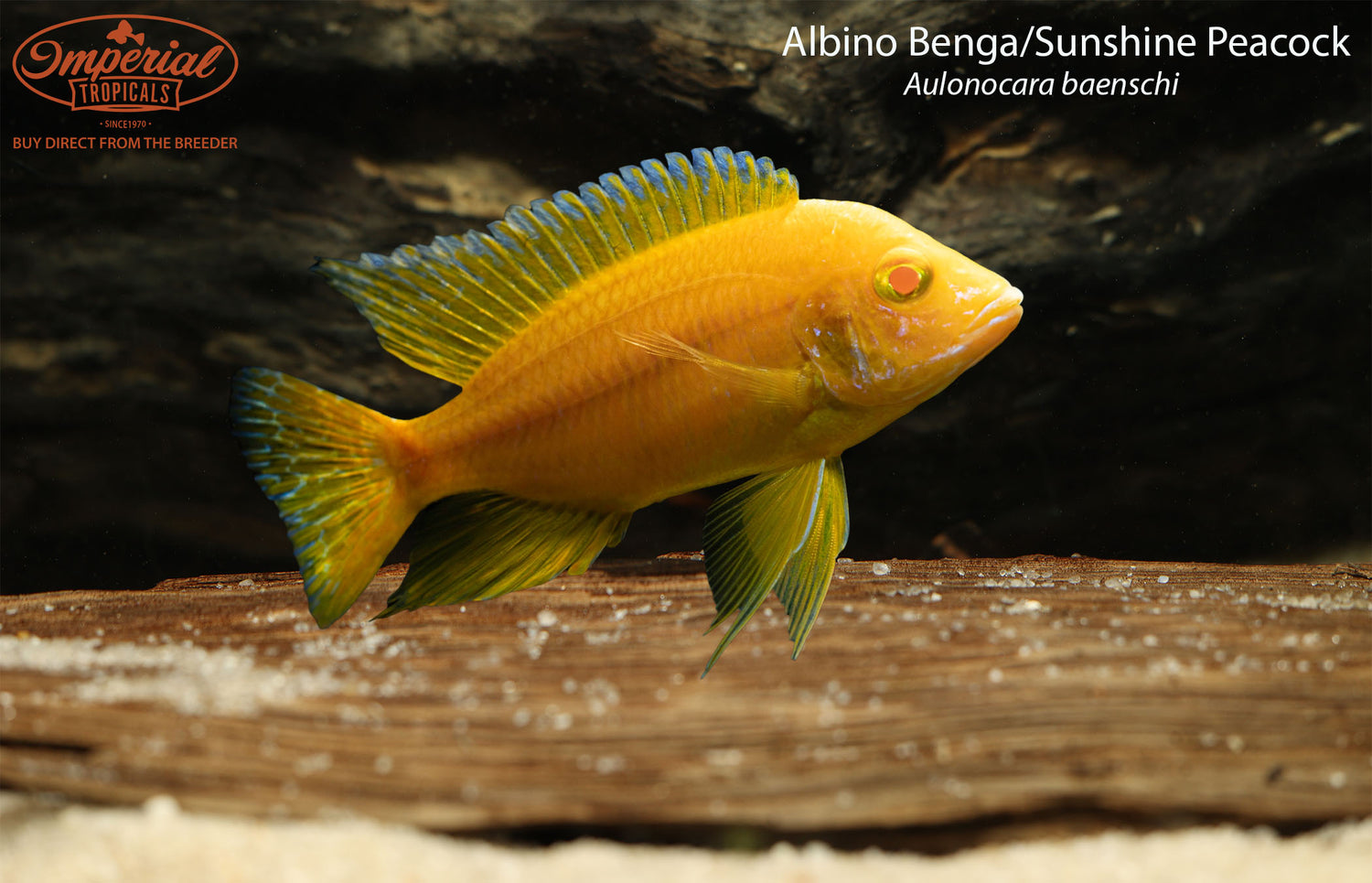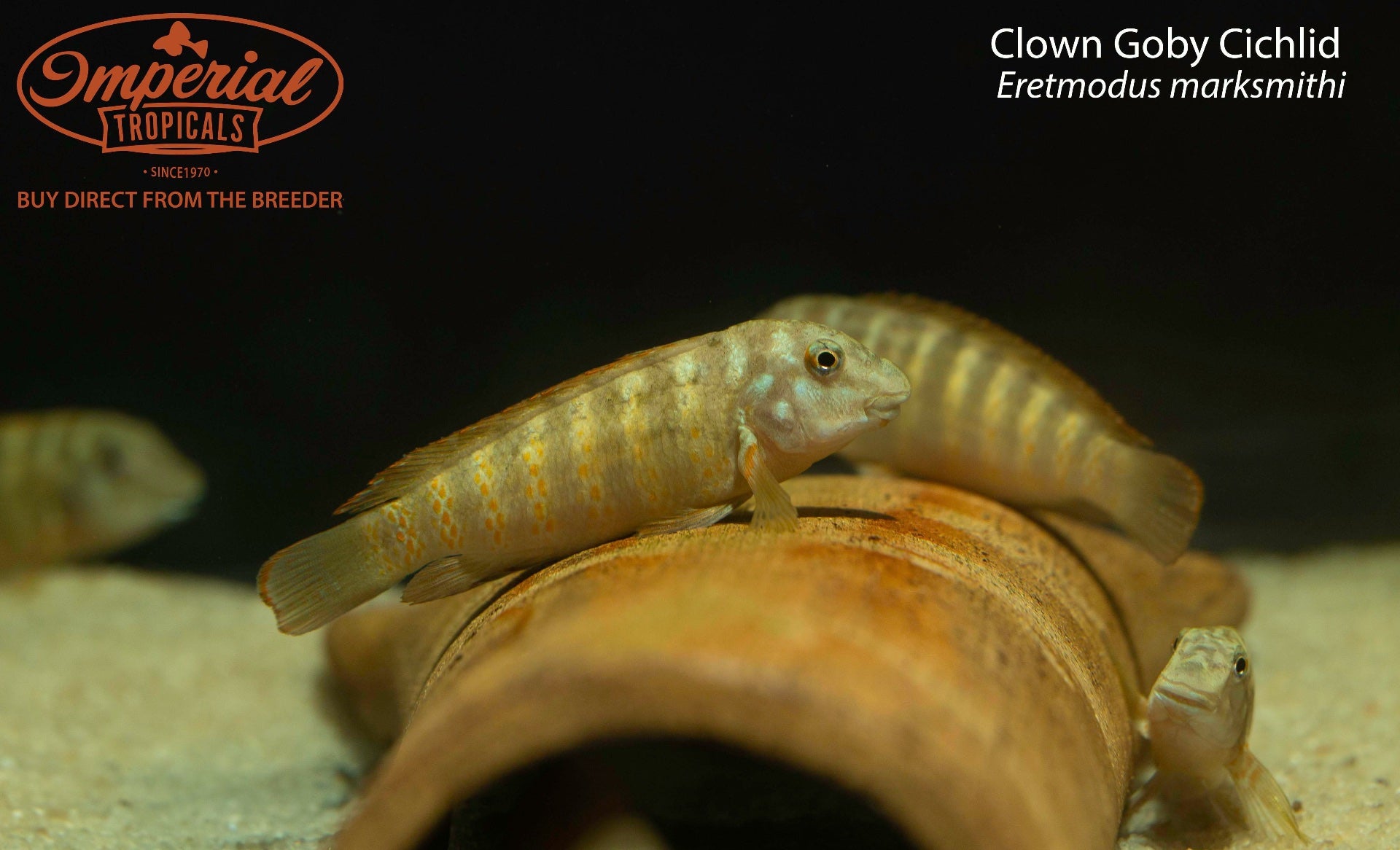Eretmodus marksmithi
Clown Goby Cichlid
Clown Goby Cichlid
Low stock: 7 left
Couldn't load pickup availability
Remarks: Clown goby cichlids are a rarely sold species of goby cichlid which are already uncommon in the hobby. Most are familiar with their close relative, the striped goby cichlid (Eretmodus cyanostictus) which they used to be considered as a subspecies of them. When the clown goby cichlid was first described back in 1988 by Konings who noted the difference between the southern and northern goby cichlid populations, it was called Eretmodus sp. “Cyanostictus North.” In 2012 after further examination, Burgess gave them their new name of Eretmodus marksmithi, solidifying the clown goby cichlid as a separate species.
As their old scientific name indicates, the clown goby cichlid can be found in the northern sections of Lake Tanganyika. There are many different localities with each having their own unique look. The most typical look for a mature clown goby cichlid is a dark brown or tan body lined with yellow or light orange stripes, iridescent blue spots on the face, and red details in their fins. Young or stressed fish tend to be more gray and tan with just hints of these colors and patterns.
Goby cichlids are found in shallow, rocky habitats in the surge zone of Lake Tanganyika. Here, the currents are strong and the dissolved oxygen levels are high. These highly adapted little fish have evolved in a way that their swim bladders have been rendered non-functional as to reduce buoyancy. This lack of buoyancy allows goby cichlids to better fight the surge currents by sticking closer to the bottom and hiding in rocky crevices. Their long but short dorsal fins and laterally compressed bodies further aid in this. The rocks that goby cichlids swim amongst tend to be covered in algae which the fish feed on as their primary source of food. Their down-turned mouths are another adaptation for their environment as it allows them to graze on this algae while remaining oriented to keep a look out for predators. Their morphology, which also includes eyes positioned at the top of the head that can move independently, is similar to fish referred to as gobies despite goby cichlids being cichlids with no close relation to gobies. Situations like this arise from a process known as convergent evolution which consists of unrelated organisms evolving similar features or behaviors independently. These similarities have given rise to their common name of goby cichlids.
Due to their natural habitat being in a surge zone, goby cichlids are used to high oxygen levels and will not tolerate poor aeration in the aquarium. They also require a very high pH, hard water, and low nitrates. To ensure their needs are attended to, those keeping goby cichlids should perform frequent water changes, use heavy filtration, and provide heavy aeration which can be achieved with bubblers and wavemakers. Using a wavemaker to create heavy current will be appreciated by the goby cichlid as this mimics their natural habitat, encouraging more of their natural behaviors. With them not being very forgiving in these regards, goby cichlids are known to not be the easiest Tanganyikan cichlids to keep and are better suited for experienced keepers. Algae should be allowed to grow within the aquarium for the fish to graze on in-between feedings. Being herbivores, a diet high in vegetable matter and algae is recommended. Spirulina flakes, sinking tablets, and fresh vegetables are all good choices. Meatier foods such as mysis shrimp can very rarely be offered as a treat as feeding too much protein will cause digestive issues such as bloat. Many suspect sand plays a vital role in their digestion so it is recommended to use soft sand as a substrate.
While goby cichlids are small, they are rather fierce and territorial. Other fish that do not dwell in the same areas of the tank as them and do not look like them tend to be left alone, but they can be very feisty toward conspecifics and members of their own kind. This is why goby cichlids are best kept as a single fish or in mated pairs. If kept like this, they can be kept in smaller tanks (20+gallons), but those looking to have a colony will need to house them in a much larger space (50+gallons). With these personalities and their herbivorous diet, goby cichlids can be a great tankmate for Tropheus. Shell dwellers and sardine cichlids are also great choices to house alongside goby cichlids.
If one is not looking to keep goby cichlids in a community setting and instead is looking to breed them, it is good to know they are a challenging project. Goby cichlids don’t breed very readily in captivity with little being known about how to trigger them to spawn. This difficulty also comes from the fact that goby cichlids can be very picky about pairing up. Just because you have a male and a female does not mean they will accept each other. This is why it is best to either get a pre-established pair or get a group of juveniles and let them pair up naturally. Once a pair has formed, they will stay together for life. There are few differences between males and females except for the fact males tend to grow larger. Goby cichlids pick a clean, flat surface, usually a rock, to spawn on. They are bi-parental mouthbrooders so the female will pick up and hold the eggs in her mouth after spawning until they hatch. She then transfers them to the male’s mouth for him to hold for a few weeks until the fry are able to fend for themselves. Goby cichlids prove to be great parents by never predating upon their own fry and protecting their brood fiercely against would be predators. Their co-operative parenting style is unique among fish and very fascinating to watch in captivity.
Animal Data
Animal Data
- Native to: Lake Tanganyika, Africa
- Breeding: Tank-raised in USA
- Max adult size: 3-4"
- Diet: Herbivore
- Social behavior: Semi-aggressive
- Care skill: Intermediate
Tank Parameters
Tank Parameters
- Temp range: 75°F - 82°F
- pH range: 8.0 - 9.0
- TDS range: 200 ppm - 400 ppm
- Min Tank Size: 20 gal
Shipping Info
Shipping Info
We provide premium next day air shipping at affordable flat rates to minimize transit time for the health of the fish.
| US Zone 1 | UPS/FedEx Overnight | $39.99 |
| US Zone 2 | UPS/FedEx Overnight | $49.99 |
| US Zone 3 | UPS/FedEx Overnight | $59.99 |
| US Zone 4 |
UPS/FedEx Overnight |
$69.99 |
| Puerto Rico, Hawaii, Alaska | UPS/FedEx Overnight 1-2 Day Air | Starts at $89.99 |
| Canada | UPS/FedEx Overnight -2 Day Air | Starts at $89.99 |
| Florida | UPS/FedEx 1 Day Ground | $19.99 |
| Local pickup | Select at checkout | No charge |
| No overseas shipping | ||
Minimum order for all shipping is $50 for mainland US, $100 elsewhere. Saturday delivery available for an extra $30. Shipping to Alaska and Canada is not flat rate and can be subject to additional fees based on location.
Important order and shipping info
Allow 2-4 business days to process and pack your order. You will receive a notification when it actually ships. Order cancellations are subject to a 10% restocking fee. Order changes cannot be made. However, if you wish to add to your order within 24 hours, you may place a second order with a request to combine the shipments. We will do our best to accommodate, however once an order is packaged and sealed it cannot be reopened.
Your order is covered by our Healthy & Happy Arrival Guarantee.
Share

Why buy from us?

Our Healthy & Happy Arrival guarantee
We've been packing and shipping live fish for over 50 years. When you buy from us, you get the healthiest stock and most experienced live fish shipping in the industry. So you know you won't be disappointed!
Watch how we prepare your animals for shipping
Ordering FAQs
Will my fish look like the picture?
The majority of fish on our website will NOT look like their photos upon their unboxing. Fish change in appearance depending on many factors, including mood, age, gender, and social status. Fish will naturally lose color during shipping and may appear faded upon arrival. Pictures are used as examples only. Pictures may be of mature fish with full color or juvenile fish without color. We encourage you to research the species as much as possible prior to ordering in order to familiarize yourself with the various appearances they may take on. Many species have females that look drastically different to their male counterparts, and many juveniles will not have as much color (or different colors) as their adult forms. If you have questions about how the fish will look, please review their information and email us if you have any questions.
How do I know which fish can go together in my tank?
Research the product descriptions on our website and use Google search to help decide which fish can go together. PLEASE do your research and email us if you have any questions. Also, we have a very active Facebook group called Imperial Tropicals Fishkeepers where you can learn from knowledgable and experienced fishkeepers.
How do you ship live fish? Sounds risky!
We've been shipping live fish for over 50 years. we use specialized packaging and techniques to ensure their health. See how we do it.
How much does shipping cost?
We provide premium next day air shipping at affordable flat rates to minimize transit time for the health of the fish.
| US Zone 1 | UPS/FedEx Overnight | $39.99 |
| US Zone 2 | UPS/FedEx Overnight | $49.99 |
| US Zone 3 | UPS/FedEx Overnight | $59.99 |
| US Zone 4 |
UPS/FedEx Overnight |
$69.99 |
| Puerto Rico, Hawaii, Alaska | UPS/FedEx Overnight 1-2 Day Air | Starts at $89.99 |
| Canada | UPS/FedEx Overnight -2 Day Air | Starts at $89.99 |
| Florida | UPS/FedEx 1 Day Ground | $19.99 |
| Local pickup | Select at checkout | No charge |
| No overseas shipping | ||
Minimum order for all shipping is $50 for mainland US, $100 elsewhere. Saturday delivery available for an extra $30. Shipping to Alaska and Canada is not flat rate and can be subject to additional fees based on location.
Important order and shipping info
Allow 2-4 business days to process and pack your order. You will receive a notification when it actually ships. Order cancellations are subject to a 10% restocking fee. Order changes cannot be made. However, if you wish to add to your order within 24 hours, you may place a second order with a request to combine the shipments. We will do our best to accommodate, however once an order is packaged and sealed it cannot be reopened.
Your order is covered by our Healthy & Happy Arrival Guarantee.
When will I get my order?
We need 2-4 days to select and pack your fish, you'll get a notification when it ships along with tracking info. It will arrive the next day or day after, depending on your location. See our Shipping Policy for full info.
What if my order is delayed? Will my fish be OK?
We ship hundreds of packages a week, and most are delivered without any issues thanks to our experienced team and premium air courier service. Our high-tech packaging is designed to sustain the animals a minimum of 2-3 days in the box, and in some cases longer, depending on the breed.
However, sometimes delays do occur. If this happens to your order, please document and contact us promptly following our inspection and documentation policies above in order to receive credit.
Can I change or cancel my order after it is placed?
Orders can be changed or cancelled within 24 hours, subject to a 10% restocking fee. Shipping is stressful for the animals and we cannot open boxes once they have been prepped and packed.
Can you hold my order until my tank is ready?
We can hold for a few days, but not beyond a week as inventory changes rapidly. Please only place your order when you know you will be ready to receive them.
What if my order is missing something?
First, please check the box and packaging thoroughly. If you are sure an item is missing please contact us immediately.
Do you offer pickup on local orders?
Yes! Just specify local pickup as your shipping option in checkout and we'll let you know when it is ready.
What if a fish I receive seems dead, sick or doesn't look right?
97% of our orders arrive without an issue. But if something goes wrong, no worries! You're covered under our Healthy & Happy Arrival Guarantee



